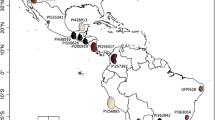Summary
Bacteria were isolated from ineffective nodules ofPhaseolus multiflorus growing in a natural environment. These bacteria gave effective nodule formation onTrifolium repens and ineffective nodule formation on Phaseolus, Pisum andVicia Faba.
An effective clover strain isolated fromTrifolium pratense induced ineffective nodule formation onMedicago sativa andVicia Faba.
An effective lucerne strain produced ineffective nodule formation on peas. An effective lupine strain produced ineffective nodule formation with very few and small nodules on lucerne.
After re-isolations and testing on the original host plant the original form of nodules was always produced.
Similar content being viewed by others
References
Allen, O. N. and Allen, Ethel K., Root nodule bacteria of some tropical leguminous plants: II. Cross-inoculation tests within the cowpea group. Soil Sci.47, 63–76 (1939).
Allen, O. N. and Allen, Ethel K., Response of the peanut plant to inoculation with Rhizobia, with special reference to morphological development of the nodules. Botan. Gaz.102, 121–142 (1940).
Bjälfve, G., Ett urval ur arkivet för bild- och försöksmaterial med baljävxter och baljväxtkulturer. Lantbrukshögsk. Baljväxtlab. Medd.13, 1–20 (1960).
Bjälfve, G., Baljväxtbakteriernas effektivitet. Mjölkpropagandan38, 94–95 (1961).
Bjälfve, G., Baljväxtbakteriernas effektivitet. Lantbrukshögsk. Baljväxtlab. Förhandsmedd.10, 1–8 (1961).
Gregory, K. F. and Allen, O. N., Physiological variations and host plant specificities of Rhizobia isolated fromCaragana arborescens L. Can. J. Bot.31, 730–738 (1953).
Jensen, H. L., The classification of the Rhizobia, pp. 75–86in: Nutrition of the Legumes. Butterworths Sciencitif Publications (1958).
Kleczkowska, J., Nutman, P. S. and Bond, G., Note on the ability of certain strains of Rhizobium from peas and clover to infect each other's host plants. J. Bacteriol.48, 673–675 (1944).
Sarich, Z., Some peculiarities ofRhizobium lupini andRhizobium japonicum. Mikrobiologija29, 701–703 (1960).
Saubert, Synnöve, Private communication (1961).
Wilson, J. K., Leguminous plants and their associated organisms. Cornell Univ. Agr. Expt. Sta. Mem.221, 1–48 (1939).
Wilson, J. K., Over five hundred reasons for abandoning the cross-inoculation groups of the legumes. Soil Sci.58, 61–69 (1944).
Author information
Authors and Affiliations
Rights and permissions
About this article
Cite this article
Bjälfve, G. The effectiveness of nodule bacteria. Plant Soil 18, 70–76 (1963). https://doi.org/10.1007/BF01391681
Received:
Issue Date:
DOI: https://doi.org/10.1007/BF01391681




